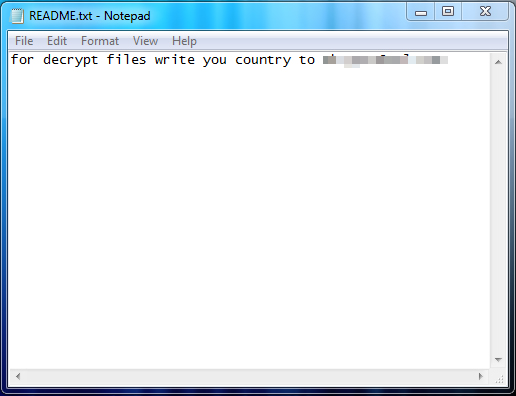RANSOM_CRYPICH.F117EV
Generic.Ransom.Cryak.A02E7E6F (BITFENDER)
Windows


Threat Type: Ransomware
Destructiveness: No
Encrypted: No
In the wild: Yes
OVERVIEW
This Ransomware arrives on a system as a file dropped by other malware or as a file downloaded unknowingly by users when visiting malicious sites.
It drops files as ransom note.
TECHNICAL DETAILS
Arrival Details
This Ransomware arrives on a system as a file dropped by other malware or as a file downloaded unknowingly by users when visiting malicious sites.
Other Details
This Ransomware does the following:
- Displays the following window upon running:

Ransomware Routine
This Ransomware renames encrypted files using the following names:
- email-{contact e-mail}.{malware version}.{encryption id}.randomname-{30 random letters}.{3 random letters}.{3 random letters}
It drops the following file(s) as ransom note:
- {folder of encryted files}\README.txt

NOTES:
The following are the fields and actions available:
- Contact email - email to be included on the renamed encrypted filename
- Encrypt folders with subfolders - enable or disable recursive encryption
- Encrypt All - encrypt all available drives and ignore folder list
- Autodelete after encrypt - ability to delete itself after encryption
- NOD mode - when enabled, ot adds the following process instead of encrypting files from main process:
•-cmd.exe {filepath to encrypt} {argument 1} {argument 2} {argument 3} - Not encrypted file extension list - list of avoided extension, with the following default values:
• sys
• dll
• ini
• log
• dat
• bmp
• png
• bat
• exe
• com
• bin - Folder List - contains a list of folders to encrypt if Encrypt all checkbox is disabled
- Start - starts encryption with current settings
- Press to hide - hides the window
SOLUTION
Step 1
Before doing any scans, Windows XP, Windows Vista, and Windows 7 users must disable System Restore to allow full scanning of their computers.
Step 2
Note that not all files, folders, and registry keys and entries are installed on your computer during this malware's/spyware's/grayware's execution. This may be due to incomplete installation or other operating system conditions. If you do not find the same files/folders/registry information, please proceed to the next step.
Step 3
Search and delete these files
- {folder of encrypted files}\README.txt
Step 4
Scan your computer with your Trend Micro product to delete files detected as RANSOM_CRYPICH.F117EV. If the detected files have already been cleaned, deleted, or quarantined by your Trend Micro product, no further step is required. You may opt to simply delete the quarantined files. Please check this Knowledge Base page for more information.
Step 5
Restore encrypted files from backup.
Did this description help? Tell us how we did.

